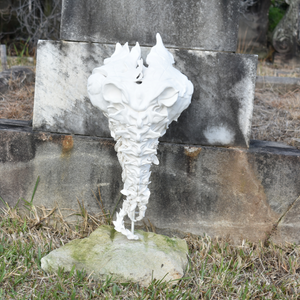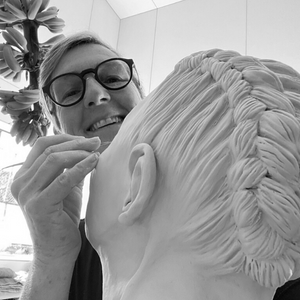Butterfly Effect (2021)
Earthenware, steel and concrete

Butterfly Effect pays tribute to the invisible complexity of heritable ancestral traits and exterior environmental influences that shape and mould our bodies, minds and experiences. This sculpture fuses human anatomical bony structures with flora, morphing into an ascending surreal butterfly. In this way, Butterfly Effect contemplates the entangled embodiment of peripheral attributions that continually and cyclically imprint upon us, as we too imprint upon others and nature. This work brings a visual imaginary of the multiplicity of exterior effects, perpetually producing and reproducing our worlds.
About the Artist

Clare Nicholson lives on Gadigal Wangal land in Sydney’s Inner West. She is a sculptor and educator, with a PhD in epigenetic maternal-foetal programming from UNSW Art & Design. Clare has held several solo shows within Australia and exhibited overseas. Along with presenting at international conferences, Clare has co-authored ‘Sustaining Seas. Oceanic Space and the Politics of Care’, published by Rowman & Littlefield. Clare taught at UNSW Art & Design and currently teaches from her Haberfield studio.
Transcription
My name is Clare Nicholson and I'm a Sydney based sculptor and educator. My Sculpture, titled Butterfly Effect, is made from fired white earthenware clay and measures fifty five centimeters high, twenty four centimeters wide and twenty four centimeters deep. I made the sculpture purposely for Rookwood and, counter to most outdoor sculptures, which can be large and domineering, intentionally kept the scale small and used of fragile material because I wanted to capture a sense of the vulnerability and intimacy of emotions and conversations that takes place in sight such as Rookwood. But I also wanted to extend this conceptual statement. Butterfly effect is a surreal human vertebrae, including the pelvis, with altered anatomical Acetabulum, the bony pelvis sockets that accommodate the head of the femur.
This alteration is intended to evoke a sense of perception concerning ocellus, the mimicry eye spots found on some butterfly wings. The pelvis extends and sweeps upward, diverging into two segments, rather like Angel Wings seen in monumental symmetry, Statutory Butterfly Wings and leaves that have deep sinuses or indentations between leaf lobes growing out of the Intervertebral foramen, which are the tunnelled gaps found between the facet joints that allow the roots of the spinal nerves to radiate out from the spinal cord, are vines and other plants. These carry different leaf types and fruits, such as peers in their pods and small berries. The plants extend around and down the vertebrae, exiting at ground level. Essentially, there is an entanglement or fusion where human anatomy and non human life are both one and the same, suggesting interwoven agency between human, non human, animal and environmental relations. My work is concerned with environmental epigenetics, that is, the nascent scientific understanding that exterior environments have the ability to impress upon and influence the human body, altering gene expression and triggering acquired characteristics. Without altering the sequencing of DNA, the body and environment are now considered a gentle, independent and permeable rather than discrete entities. Of great interest is the fact that epigenetic mechanisms have been found to be transmissible across several generations. So not only do we as individuals have agency which imprints upon future generations beyond the materiality of DNA, but exterior environments have also been found to influentially trigger and alter our genetic responses. In a nutshell, epigenetically, there is a persistent heritability and entanglement between body environment relations, and this is extraordinary, carrying far reaching ramifications.
Knowing this, Rookwood symmetry is an extremely poignant site to make work about epigenetic intergenerational heritability and exterior environments. symmetries have always offered the opportunity for deep contemplation regarding memory, with ancestral links, of course, but now there's a deeper understanding of what memory is and how it becomes sematically handed on from one generation to the next. Beyond the hard wiring of genetics, nature and natural environments have been found to be beneficial to our emotional and spiritual well being, and certainly for me this is the case. The tranquility of the historical Rookwood gardens, with its diverse floor and fauna species, contributes a transformative and restorative force where I reflect and contemplate the fleeting effect my life might have on others and the environments I live within and pass through. Understanding the entanglement of every genetic, somatic environmental imprinting deepens this contemplation and by installing my sculpture at the base of a headstone consisting of an angel with upsweeping wings, echoed by the wings in Butterfly Effect, not only pays much respect to that individual grave but to the import sense of spiritual well being. My hope is that the audience will recognize, in butterfly effect that conceptually, human anatomy is fused with nature and non human animal because this fusion is important beyond simply the perpetual cycle of life and death of our immediate human lives, that my sculpture will create a visual and cognitive prompt concerning how our bodies and natural ecologies are interwoven and entangled along with spiritual well being.
The beautiful exterior environments and places of contemplation have a spiritual legacy that is interwoven somatically, playing out intangibly, fusing with and imprinting upon our body and selves, and that this agency is fleeting and vulnerable.